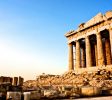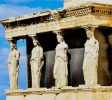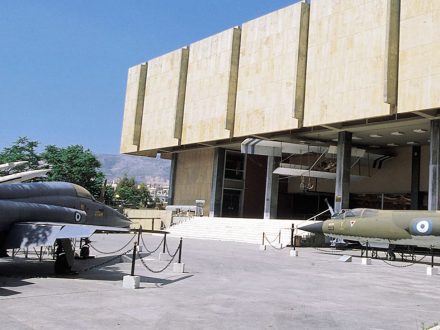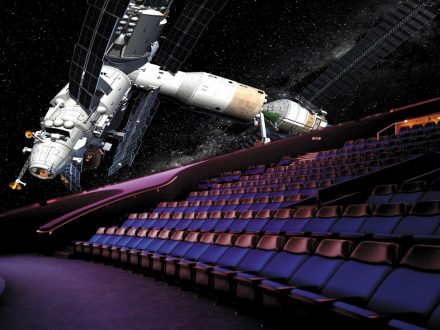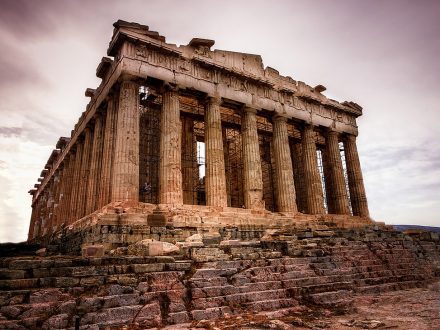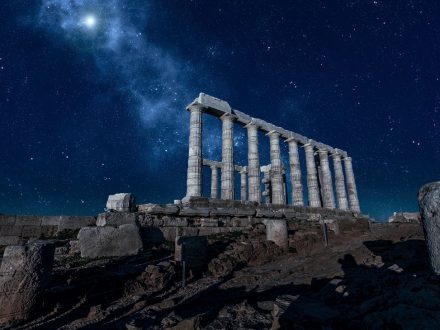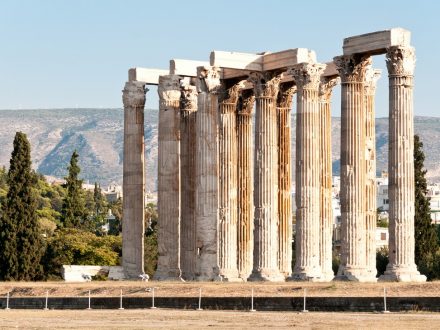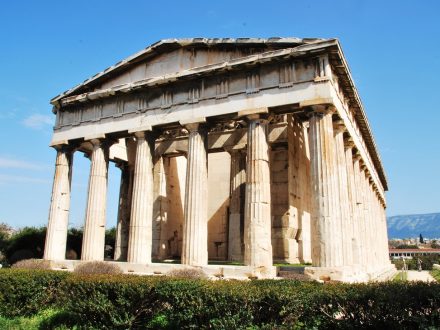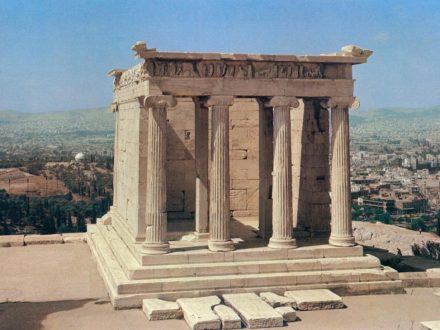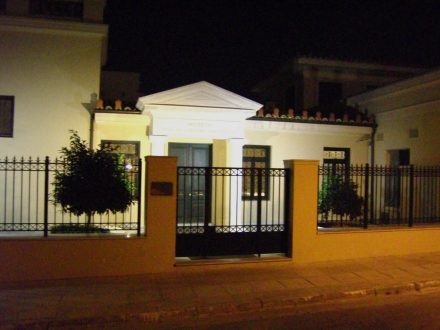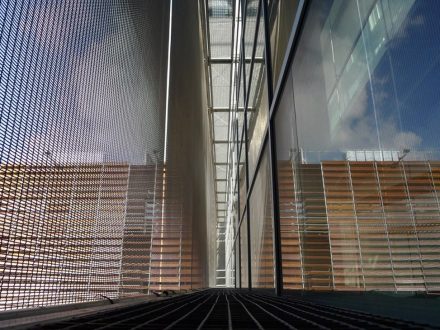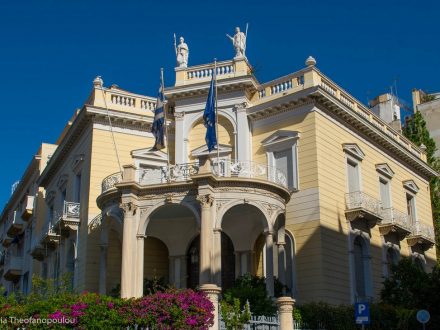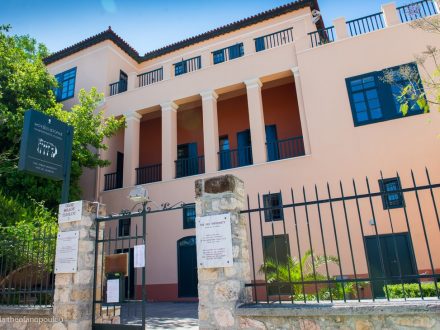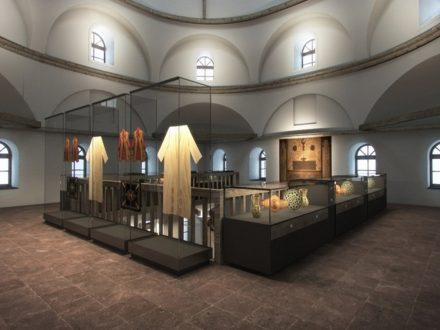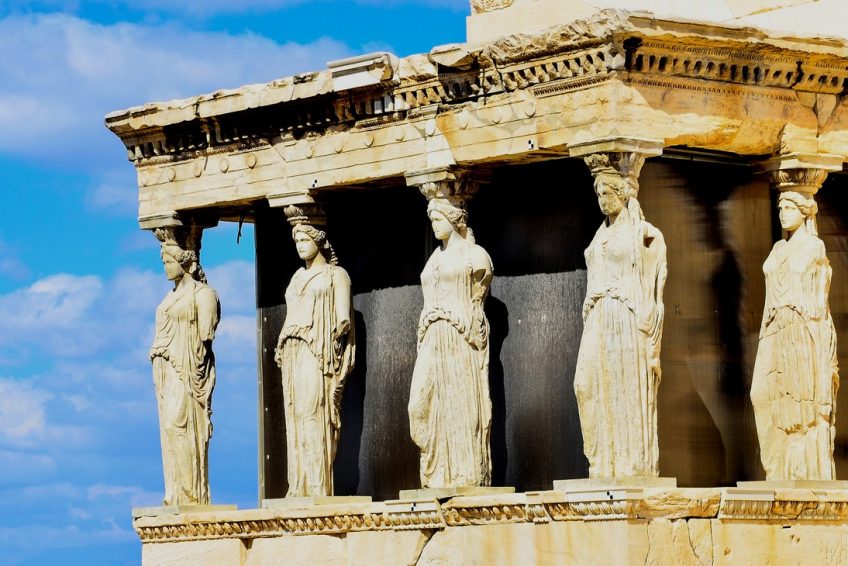
The Erechtheion or Erechtheum is an ancient Greek temple on the north side of the Acropolis of Athens in Greece which was dedicated to both Athena and Poseidon.
The temple as seen today was built between 421 and 406 BCE. Its architect may have been Mnesicles, and it derived its name from a shrine dedicated to the legendary Greek hero Erichthonius. The sculptor and mason of the structure was Phidias, who was employed by Pericles to build both the Erechtheum and the Parthenon. Some have suggested that it may have been built in honor of the legendary king Erechtheus, who is said to have been buried nearby. Erechtheus was mentioned in Homer’s Iliad as a great king and ruler of Athens during the Archaic Period, and Erechtheus and the hero Erichthonius were often syncretized. It is believed to have been a replacement for the Peisistratid temple of Athena Polias destroyed by the Persians in 480 BC.
The need to preserve multiple adjacent sacred precincts likely explains the complex design. The main structure consists of up to four compartments, the largest being the east cella, with an Ionic portico on its east end. Other current thinking would have the entire interior at the lower level and the East porch used for access to the great altar of Athena Polias via a balcony and stair and also as a public viewing platform.
The entire temple is on a slope, so the west and north sides are about 3 m (9 ft) lower than the south and east sides. It was built entirely of marble from Mount Pentelikon, with friezes of black limestone from Eleusis which bore sculptures executed in relief in white marble. It had elaborately carved doorways and windows, and its columns were ornately decorated (far more so than is visible today); they were painted, gilded and highlighted with gilt bronze and multi-colored inset glass beads. The building is known for early examples of egg-and-dart, and guilloche ornamental moldings.[5] The Theory of Mouldings, p22, J.H. Janson 1926, has detailed drawings of some of the decorations.
On the north side, there is another large porch with six Ionic columns, and on the south, the famous “Porch of the Maidens”, with six draped female figures (caryatids) as supporting columns. The porch was built to conceal the giant 15-ft beam needed to support the southwest corner over the Kekropion, after the building was drastically reduced in size and budget following the onset of the Peloponnesian war.
The Erectheum was associated with some of the most ancient and holy relics of the Athenians: the Palladion, which was a xoanon (defined as a wooden effigy fallen from heaven – not man-made) of Athena Polias (Protectress of the City); the marks of Poseidon’s trident and the salt water well (the “salt sea”) that resulted from Poseidon’s strike; the sacred olive tree that sprouted when Athena struck the rock with her spear in her successful rivalry with Poseidon for the city; the supposed burial places of the mythical kings Cecrops and Erechtheus; the sacred precincts of Cecrops’ three daughters, Herse, Pandrosus and Aglaurus; and those of the tribal heroes Pandion and Boutes. An olive tree remains on the Western side of the Erechtheus, though it was planted there in modern times by Sophia of Prussia, granddaughter of Queen Victoria, in honour of the Athenians.
The eastern part of the building was dedicated to Athena Polias, while the western part served the cult of Poseidon-Erechtheus and held the altars of Hephaistus and Voutos, brother of Erechtheus. According to the myth, Athena’s sacred snake lived there. The snake was fed honey-cakes by Canephorae, the priestesses of Athena Polias, by custom the women of the ancient family of Eteoboutadae, the supposed descendants of the hero Boutes. The snake’s occasional refusal to eat the cakes was thought a disastrous omen.
The Erechtheion underwent extensive repairs and reformation for the first time during the 1st century B.C., after its catastrophic burning by the Roman general Sulla.[9] The intact Erechtheum was extensively described by the Roman geographer Pausanias (1.26.5 – 27.3), writing a century after it had been restored in the 1st century AD.The building was altered decisively during the early Byzantine period, when it was transformed into a church dedicated to the Theometor. With this alteration many architectural features of the ancient construction were lost, so that our knowledge of the interior arrangement of the building is limited. It became a palace under Frankish rule and the residence of the Turkish commander’s harem in the Ottoman period.
In 1801 one of the caryatids and the north column of the east porch together with the overlying section of the entablature were removed by Lord Elgin in order to decorate his Scottish mansion, and were later sold to the British Museum (along with the pedimental and frieze sculpture taken from the Parthenon). Athenian legend had it that at night the remaining five Caryatids could be heard wailing for their lost sister. Elgin attempted to remove a second Caryatid; when technical difficulties arose, he tried to have it sawn to pieces. The statue was smashed, and its fragments were left behind. It was later reconstructed haphazardly with cement and iron rods. During the Greek War of Independence the building was bombarded by the Ottomans and severely damaged, the ceiling of the north porch was blown up and a large section of the lateral walls of the cella was dismantled.
The Erechtheum went through a period of restoration from 1977 to 1988.
Previous attempted restorations by Greece damaged the roof of the Caryatids’ porch with concrete patches, along with major damage caused by pollution in Athens. In 1979, the five original Caryatids were moved to the Old Acropolis Museum and replaced in situ by exact replicas. Scientists were working in 2005 to repair the damage using laser cleaning.
One of those original six figures, removed by Lord Elgin in the early 19th century, is now in the British Museum in London. The Acropolis Museum holds the other five figures, which are replaced onsite by replicas. The five originals that are in Athens are now being exhibited in the new Acropolis Museum, on a special balcony that allows visitors to view them from all sides. The pedestal for the Caryatid removed to London remains empty. As of 2011, they are being cleaned by a specially constructed laser beam, which removes accumulated soot and grime without harming the marble’s patina. Each Caryatid is cleaned in place, with a television circuit relaying the spectacle live to museum visitors. Although of the same height and build, and similarly attired and coiffed, the six Caryatids are not the same: their faces, stance, draping, and hair are carved separately; the three on the left stand on their right knee, while the three on the right stand on their left knee. Their bulky, intricately arranged hairstyles serve the crucial purpose of providing static support to their necks, which would otherwise be the thinnest and structurally weakest part.
The Caryatids have been transferred from the Old Acropolis Museum to the New Acropolis Museum. The first was carried over safely on December 9, 2007, via an elaborate system of aerial cranes.Within the new museum, the statue was reunited with its long-missing sandalled left foot, which was identified among rubble in the 1980s. The reassembled Caryatid, along with the four others remaining in Athens, are having their decayed patina thoroughly restored by laser, and are on display in the new museum. Visitors today can see this process being carried out via camera in the gallery where the Caryatids are displayed in the museum. The Acropolis Museum was awarded for its innovative program of the conservation and the restoration of the Caryatids by the International Institute for Conservation (IIC) in Vienna, with the Keck Award 2012.



